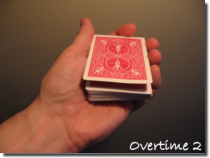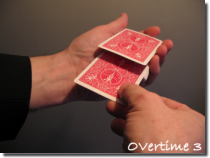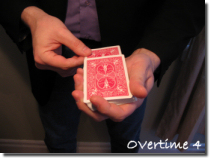Overtime
When Jeff Stone e-mailed me to ask for a previously unpublished coin routine he could post on his website, I immediately thought of this card trick from my 2004 book, Random Acts of Magic. It’s completely impromptu, virtually sleight-free, and it fools magicians as thoroughly as it fries the paying public.
To begin, spread the deck face down between your hands for a selection. Once a card has been chosen, square the pack into left-hand dealing position and direct the spectator to show his card to everyone as you turn around, presumably to avoid seeing it. During this brief moment when your back is to the audience, your right hand grasps and lifts the top half (or so) of the deck just enough for your left thumb to slip beneath the remaining (bottom) half and flip it face up.
In a continuing action, with your left thumb, drag the top card of the right-hand packet onto the left-hand packet, then place the right-hand packet beneath the left-hand packet as you square everything back into dealing position. All of this should take less than two seconds, and the order of the deck from top to bottom is now face-down indifferent card, 20 to 25 face-up cards, remainder of deck face down. Believe it or not, your work is almost done.
Turn to face the audience once more and retrieve the selection with your right hand as your left hand secretly props up the inner end of the top card for Vernon’s Illusion of Depth move (a.k.a. Tilt). That is to say, with the audience’s attention on your right hand retrieving the selection, your left thumb pushes the top card of the deck about an inch to the right so it’s resting on your second and third fingertips (PHOTO 1).
Without pausing, your third fingertip stretches out and engages the right edge of the card, then curls in, lifting the inner end a little less than an inch off the deck (PHOTO 2).


In a continuing action, with your right hand, insert the selection face down into the gap beneath the top card, but flat against the pack (PHOTO 3 is an exposed view). From the front, it looks like the card is going into the middle of the pack (i.e., Vernon’s Illusion of Depth-PHOTO 4).


Push the card flush, then grasp the pack from above with your right hand as you square it, at the same time allowing the top (tilted) card to fall flat against the pack. Say, “I’m going to show you some sleight of hand-watch carefully and see if you can catch it.” Slowly, deliberately turn the top card of the deck face-up as you would for a Double Turnover, then say, “How many cards do you think I turned over?
The spectator will reply, “One,” whereupon you say, “Actually, I turned over about half the deck,” as your left thumb pushes the top two or three cards to the right as a block, then continues spreading the deck up to and just past the first face-down card, showing about 26 face-up cards.
Pause a beat, letting the effect register, then, with your right hand, move the face-up spread to the right and turn it face down onto the block of cards in your left hand, allowing everything to square.
Say, “I’ll do it again.” Slowly, deliberately turn the entire deck face up into left-hand dealing position (I do this from the right side, like turning a page in a book), then say, “How many cards do you think I turned over that time?”
The spectator will reply, “All of them,” whereupon you say, “Actually, all of them but one,” then execute a pressure (or drag) fan with the face-up deck in your left hand, showing one card face down in the middle. Invite the spectator to remove the card and turn it over, revealing his selection.
Comments: The opening sequence with the single-card turnover resulting in a multitude of face-up cards has precedent in Roger Klause’s “First Teaser,” a double-lift gag for magicians in Virtual Foolery (Racherbaumer/Waters, 1997). And I believe Jon Racherbaumer was the first to publish a one-handed get-ready for Vernon’s Depth Illusion (Kabbala, March, 1971), but the idea had been “kicking around” (as he put it) for some time before.
-David Acer
For this and other great magic from David Acer, check out his site: www.davidacer.com
Please “like” This Effect:
